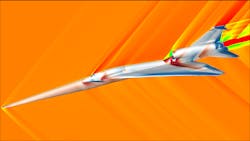Ames' contributions to the X-59 quiet supersonic technology aircraft
MOUNTAIN VIEW, Calif., - Not much has changed in commercial aircraft design and technology for the last 50 years. That's about to...well...change thanks to efforts to design future commercial aircraft capable of hushing sonic booms to a mere thump as they fly faster than the speed of sound, Rachel Hoover writes for NASA. Continue reading original article.
The Military & Aerospace Electronics take:
25 March 2022 - With no X-59 flight data – yet – computer simulation is the next best thing to build confidence in the predictions for its supersonic performance. Teams at Ames and NASA's Langley Research Center in Hampton, Virginia, worked together to ensure that multiple software codes would make similar predictions about how loud the X-59 will be in different environments.
For example, they know the boom's loudness changes based on the cloud cover and humidity of the areas below a flight path, and can give the pilot information in the cockpit that can help guide the aircraft to areas where the boom may be quieter. Computational fluid dynamics simulations also create visualizations of the X-59 aircraft concept and help researchers determine which features of the aircraft generate shockwaves that contribute to the sonic thump sound below the aircraft.
NASA is working closely with Lockheed Martin to create a large database of computational fluid dynamics simulations to verify the aircraft’s supersonic performance. The database includes simulations for all possible combinations of settings that a pilot uses to control the aircraft and the flight conditions that may be encountered. This database is crucial for supplying data for a flight-planning tool that is being used to assist and teach pilots how to fly the X-59, before it even flies.
From there, researchers can determine the best flight conditions to reduce noise when they begin piloted test flights over select U.S. cities. These flights also will provide opportunities to collect, verify, and validate data about community responses. NASA will share the data with U.S. and international regulators which will use it when considering new sound-based rules for supersonic flight over land. New rules could enable new commercial cargo and passenger markets in faster-than-sound air travel.
Related: NASA's experimental X-59 supersonic jet could be built by the end of 2020
Related: Lockheed Martin’s supersonic X-59 could transform everything
Related: A view of NASA’s X-59 engine inlet
Jamie Whitney, Associate Editor
Intelligent Aerospace
